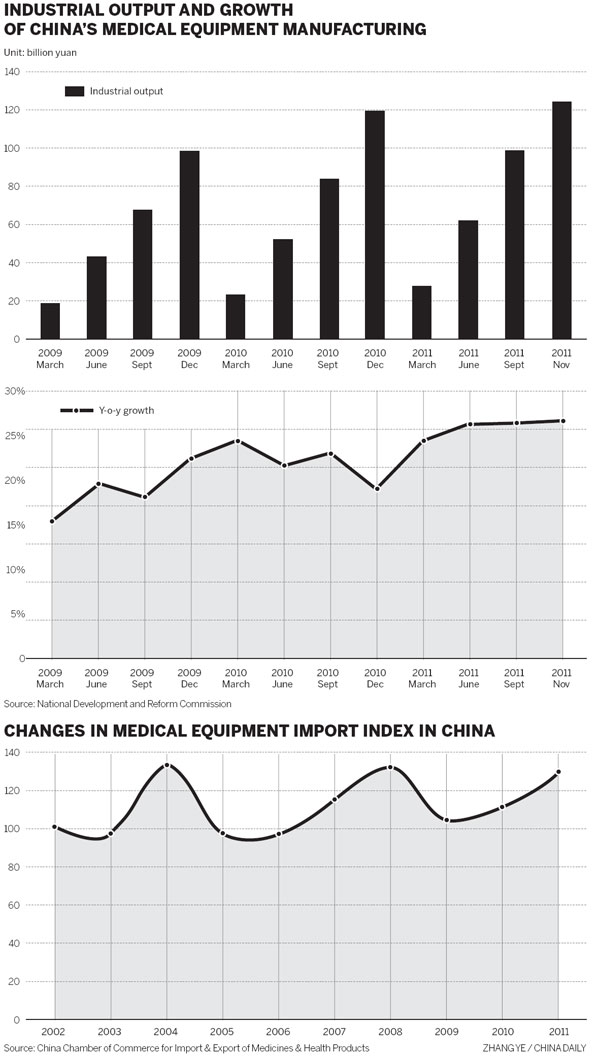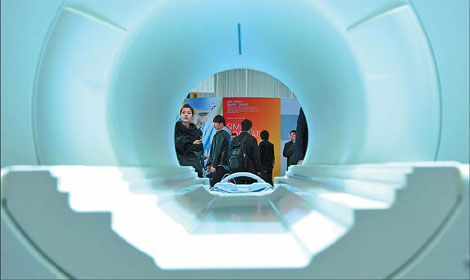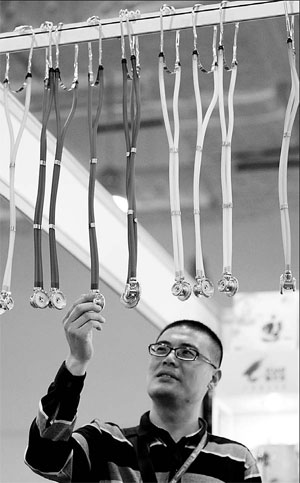High-tech devices improve healthcare
|
An image seen through a CT scanner at an international medical equipment exhibition in Beijing. Domestic makers are challenging foreign big names as the Chinese market expands. Hu Xuebai / For China Daily |
Domestic startups challenge global giants for a share of vast market
Two-year-old Jiang Jie, who saw his father die of disease and his mother run away from home, lives with his grandparents in Wuyapo village, a mountainous area about a three-hour drive from Chengdu.
The boy is thinner and shorter than other kids of his age and had complained of feeling weak. However, his grandparents were too old and too poor to take him to a hospital in Chengdu, the capital city of Southwest China's Sichuan province.
Luckily, Jiang Jie was examined by a team of doctors who came to his village with high-tech, smartphone-like devices. They diagnosed him as having congenital heart disease.
"The boy can be as healthy as ordinary boys after an operation; otherwise, he may continue to be very weak and die at a young age," said Hu Dayi, the leader of the team and director of the cardiovascular disease department at Peking University People's Hospital.
"Early diagnosis enables patients to get early treatment and may even save their lives," Hu said. "These small, portable, multi-functional devices allow us to better serve remote areas."
The device which may have saved Jiang Jie's life is called Vscan. Priced at $7,999, it was introduced to China last May by GE Healthcare, a medical arm of General Electric Co. It provides ultrasound imaging, measurement and analysis of the human body and clinical detection of various diseases.
"It is like a small mobile scanning room. The compact size, high degree of portability, and simplified user interface make our work easier and more efficient," said Hu.
Vast rural market
In recent years, GE Healthcare has introduced a series of small, portable, and relatively inexpensive devices to China. It is aiming at the nation's vast grassroots market, including hospitals in small and medium-sized cities and counties, as well as clinics in rural areas and urban residential communities.
The US-based medical equipment provider is not alone in China: A group of multinational medical device companies, including Siemens Healthcare, Philips Healthcare, and Toshiba Medical System Co, are developing products tailored to China's grassroots market.
Last June, Philips Healthcare, a subsidiary of Royal Philips Electronics Ltd, set up its second Chinese regional headquarters in Chengdu to facilitate a planned expansion in western China.
In October, Siemens Healthcare, the medical arm of Siemens AG, established a research institute, intended to develop high-quality, low-cost imaging equipment to serve China's grassroots communities.
"They are looking at huge market potential here, which is being stimulated by China's new medical reform policies," said Hu Jin, an analyst with Huatai Securities Co Ltd.
In mid-March, the Chinese government issued new medical reform policies, which make infrastructure construction and equipment upgrades at grassroots medical institutions among its top priorities for healthcare in the 2011-2015 period.
According to Guo Fanli, an analyst with China Investment Consulting Co Ltd, medical institutions in China's rural areas account for only 7 percent of the nation's total, while providing service to about 60 percent of China's 1.3 billion people.
"The central government is determined to fundamentally improve grassroots health care services. In 2009, investment in rural medical infrastructure amounted to 2.7 billion yuan ($429 million)," said Guo. He predicted that government funding of this sector will reach dozens of billion yuan by 2015.
Medical equipment sales in China amounted to 135 billion yuan in 2011, about 26.6 percent more than the previous year, according to a report by China Economic Information Network, a domestic information service provider affiliated with the State Information Center. The report predicted that the market will grow rapidly in the next five to 10 years, with a compound annual growth rate of 20 to 30 percent.
Rachel Duan, China president and CEO of GE Healthcare, told China Daily that sales to China's grassroots market will increase to half of the company's business in China within five years, from less than 20 percent at present.
"We will launch 32 new products here over the next three to four years, 70 percent of them tailored to grassroots medical care institutions," she said. "Seven will be launched this year and another 25 are expected in the coming two to three years."
Bernd Montag, CEO of the Imaging and IT Division of Siemens Healthcare, said one of the company's top priorities in the coming years is IT solution development, intended to "cover more patients at less cost". Mobile and wireless technologies, coupled with the Internet, make long-distance diagnosis and data sharing possible. Using portable devices, healthcare personnel can do on-site examinations in inaccessible locations and get professional diagnosis and therapy suggestions from large medical centers, greatly improving grassroots medical services, he said.
Big competition
Multinational companies are not alone in their enthusiasm for China's grassroots market. There is increasingly intense competition in key cities, where domestic players are becoming more competitive with new technologies and products, said Hu of Huatai Securities.
In January, China issued its 12th Five-Year Development Plan for the Medical Equipment Industry, which calls for the government to fund large research and development projects conducted by domestic companies and to support industry consolidation.
So far, the government has provided nearly 1 billion yuan to dozens of R&D projects. It will support the development of 10 to 15 large Chinese medical device companies by providing preferential land and taxation, as well as streamlined product registration and approval procedures and public tender rights. The goal is to build eight to 10 medical device giants, each with an annual output worth more than 5 billion yuan.
Shenzhen-based Mindray Medical International Ltd, set up in 1991, has become one of the top 10 Chinese medical equipment producers by sales. Its annual sales are expected to exceed 10 billion yuan by 2015, according to CEO Liu Jie.
Today, the company's products are found in 95 percent of China's major hospitals; its patient monitoring equipment has ranked first in sales for 11 consecutive years. Its latest product - an iPad-like patient monitor - is selling well, both in China and overseas.
Ten years ago, a patient monitoring device was priced at more than 100,000 yuan. Today it costs no more than 50,000 yuan.
"Foreign giants, which dominated China's high-end (medical device) market, did not want to reduce prices. However, they were forced to do so, because our products have the same quality and are priced lower. If they maintain their high prices, they will lose the market," said Liu.
So far, three top international companies, GE Healthcare, Philips Healthcare, and Siemens Healthcare, occupy about 70 percent of China's high-end medical device market.
Mindray, which does business in more than 100 nations and regions, expects its business to grow faster domestically than overseas.
Better care?
|
A medical equipment and device exhibition in Jinan, Shandong province. The booming household medical device market has led to fierce competition in major Chinese cities as well as rural areas as international and domestic manufacturers seek to update technologies and offer better services to grab more market share. Liang Zhijie / For China Daily |
Such advances in technology do not always translate directly into savings or better care for patients, however.
Luo Jiansheng, 56, suffers from cardiovascular disease and usually visits the China-Japan Friendship Hospital in Beijing.
"For a general examination, such as a blood test or an electrocardiogram, the prices have remained relatively stable, compared with the overall inflation of recent years. However, for some complicated tests, such as nuclear magnetic resonance and ultrasonic examinations, the prices have jumped as much as 300 to 400 percent over the last five years," he said.
Luo considered seeing doctors in community clinics or other medium-sized hospitals, but was told that all his tests would need to be done again at the new facility.
"I don't know why I should pay to have the same tests done again and again if I change hospitals," he said.
Li Hongshan, executive vice-president of the Chinese Hospital Association, admitted duplication of services is a problem.
"That's mainly due to the lack of a unified database among medical institutions in China," he said. "On the other hand, we cannot deny that some hospitals are making money (from duplicate examinations)."
In addition to improved medical technologies and devices, many other new products have been developed to make diagnosis more accurate and treatment more targeted. These may help tailor therapies, reducing both the cost and discomfort experienced by patients, Li added.
Profit margins
While technological advances may improve patient care, their profitability remains to be seen.
"Sales at grassroots medical institutions are expected to be about equal to those at major hospitals, since the majority of products sold to rural and community institutions are low cost," said Hu.
Guo predicted the growth in sales to the grassroots market will be higher because of the size of the market and strong government support. However, the government is expected to try to reduce medical care costs, which in turn "forces hospitals to decrease examination charges and purchase equipment... at affordable prices", Guo said.
Rachel Duan of GE Healthcare China said that expansion into the grassroots market will not affect her company's performance, since quality and high cost-efficiency will help guarantee better profits.
"The profit margin of these products will not be lower than that of high-end equipment due to the cost savings brought about by technological development and integration of products and solutions," she said.
Thirty percent of components used by GE Healthcare are purchased from domestic suppliers. The company has three R&D facilities: in Beijing, Wuxi and Chengdu.
Advances in technology will lead to new products and help reduce the cost of traditional equipment, added Bernd Montag of Siemens Healthcare.
Japan-based Toshiba is another of the pioneers to tap China's rural areas. Sales of equipment from Toshiba Medical System (China) Co Ltd in China have been growing at 35 to 40 percent annually since 2007, contributing about 10 percent of Toshiba's global business last year.
"I believe the greatest headaches for multinational companies are distribution, relationships with grassroots government, qualified sales staff and cost reduction," said Li.
liujie@chinadaily.com.cn

(China Daily 04/16/2012 page13)
















